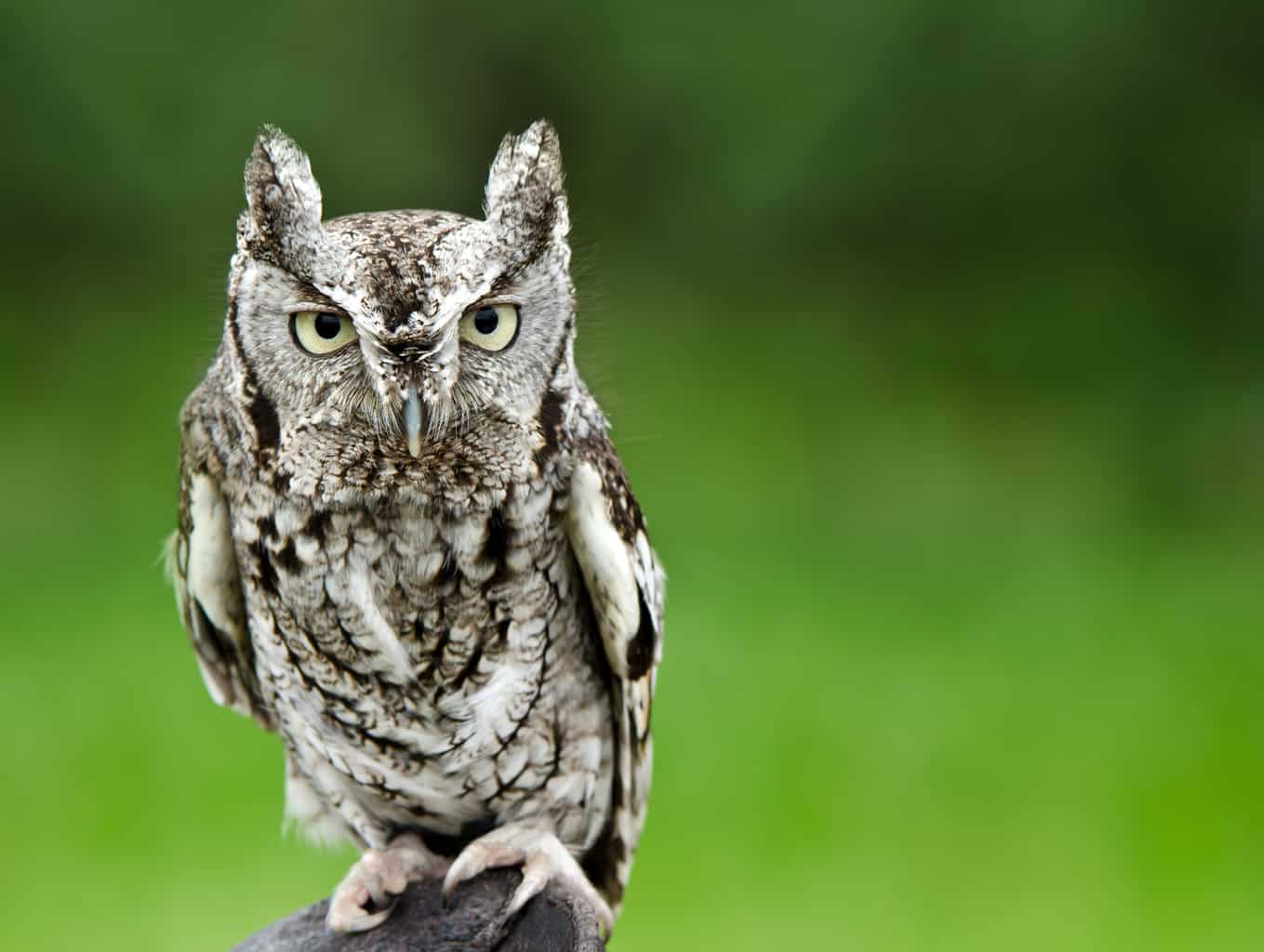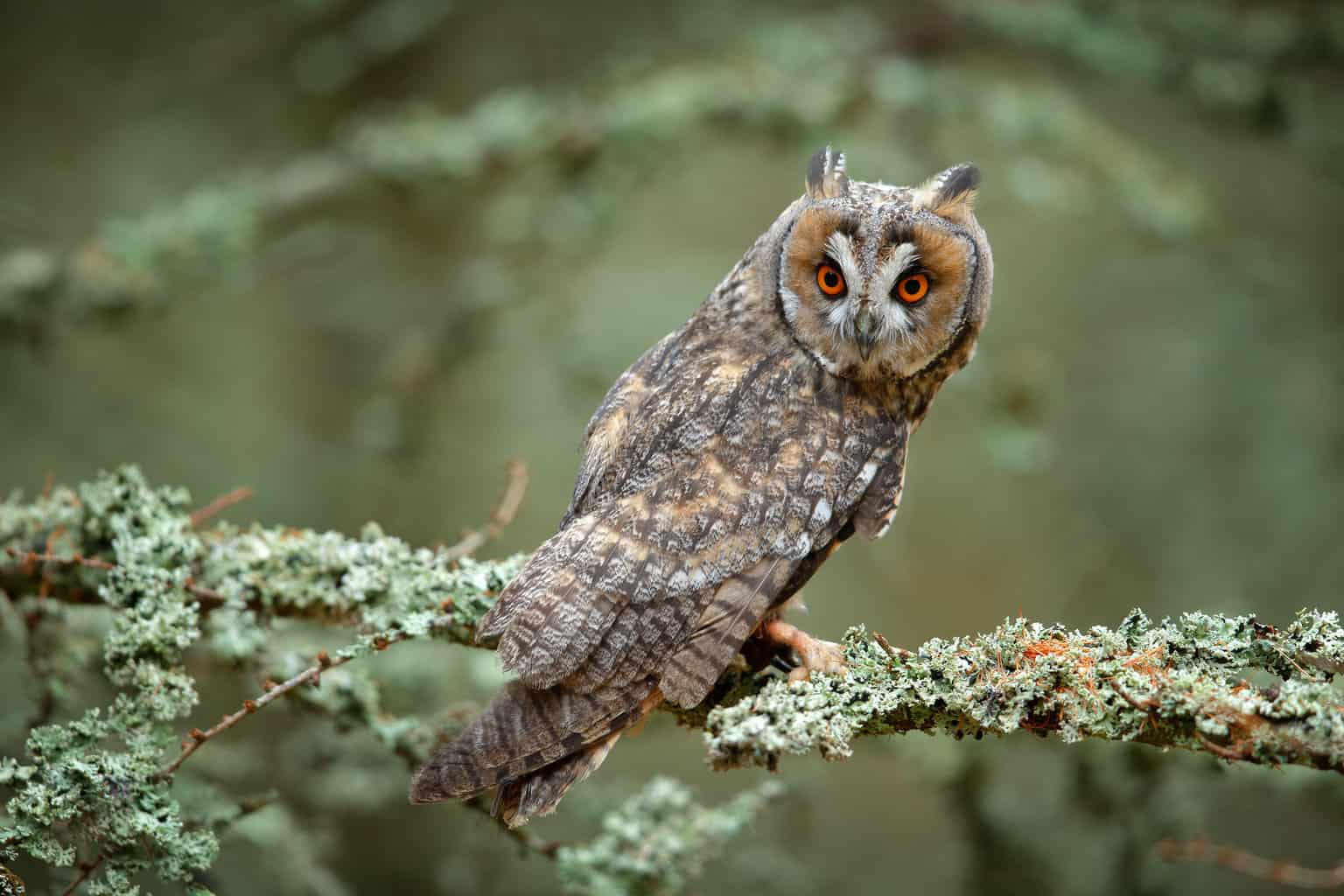Did you know that there are more tree farms in Mississippi than in any other state? These forests make up more than 60% of the land, which comes down to about 19.5 million acres!
Nicknamed the “Magnolia State,” this southern state is famous for its unique and remarkable geography.
Another natural blessing is its year-round moderate climate. All these factors come together to create a nice mix of diverse wildlife, including seven of the most common flying night predators in North America: the owl.
In this post, we’re focusing on seven owls in Mississippi. We’ll tell you some interesting facts about each one and how you can spot them.
Even if you’re not an avid birdwatcher, this is one post you won’t want to miss!
Eastern Screech Owl

- Scientific Name: Megascops asio
- Length: 6.3 – 10 in
- Weight: 4 – 9 oz
- Wingspan: 19 – 24 in
Additional Information:
Eastern Screech owls are stocky and well-built like professional bodybuilders. Still, they’re pretty lightweight, compared with larger owls like the Great Horned owl.
Their coloring ranges from shades of grey and red. Yet, what makes them stand out is the two clumps of feathers on top of their heads that look like ears.
While these may not be their real ears, they’re not just there to look pretty. These patches of feathering help them communicate with other owls, whether it’s a friend or foe.
They’re one of the most common owls in Mississippi. This is a direct result of their ability to acclimate to their surroundings.
These year-round Mississippians will build their nesting almost anywhere. However, they avoid areas where there are larger owl species and other raptors.
You can spot them along highways, inside buildings, or on top of streetlamps.
The diet of the Eastern Screech Owl consists of reptiles, fish, insects, rodents, and small birds. They’re opportunistic hunters, which means they eat what’s readily available.
Short-Eared Owl

- Scientific Name: Asio flammeus
- Length: 13 – 17 in
- Weight: 7 – 17 oz
- Wingspan: 33.5 – 40.5 in
Additional Information:
While they may be called ‘Short-eared,’ these owls rarely show their fake ears. What should get your attention is their Latin name, Asio flammeus. It refers to the orange, flame-colored feathering that covers most of their bodies.
Short-eared owls are seasonal breeders. They head north to breed, then return to the south during the winter.
You can spot them either at dusk or dawn flying over meadows and grasslands. It’s also where they typically build their nests, where food is abundant.
Their diet consists of rodents, especially voles, which is their favorite meal. Besides hunting small mammals, Short-eared owls hunt seabirds and small songbirds.
These nocturnal birds aren’t big on hooting. In fact, they rarely make any noises at all.
The good news is that they’re day hunters. So, you can easily recognize them if you find yourself in one of their hunting spots.
Long-Eared Owl

- Scientific Name: Asio otus
- Length: 14 – 16 in
- Weight: 8 – 15 oz
- Wingspan: 35 – 39 in
Additional Information:
Named for its long tufts of fake ears, the Long-eared owl is best known for its powerful and various calls. It hoots, screeches, and even makes a sound that resembles barking.
Keep a look out for Long-eared owls throughout the year in forests and wooded areas. This is where they enjoy setting up their nesting grounds because it helps them stay hidden from other raptors.
Just bear in mind that they’re quite secretive and like to keep to themselves. Yet, if you spot several owls roosting in groups during the winter, it’s probably a group of Long-eared owls.
When it comes to hunting, these night-hunting birds prefer searching for food in open areas, such as meadows and grasslands.
These super-quiet, super-stealthy night predators are characterized by their excellent hearing. It’s so precise they can easily capture their prey in complete darkness.
Northern Saw-Whet Owl

- Scientific Name: Aegolius acadicus
- Length: 7 – 8 in
- Weight: 2 – 5 oz
- Wingspan: 16.5 – 19 in
Additional Information:
The Northern Saw-whet owl is the smallest on our list. It’s almost the size of a robin, which means that a tiny mouse can mean an entire banquet.
Their small size, as well as the fact that they’re migratory birds, makes them difficult to spot. They’re also night hunters and can be hard to recognize in the dark.
One way to identify them is through their distinct and varied calls. One unmistakable sound they make sounds like a too-too-too, which they repeat several times in a row.
Their name comes from their typical call, which sounds like the sharpening of a saw on a stone. They’re typically quite vocal and can be heard up to half a mile away.
While in Mississippi for the winter, these dainty birds set up their nests in deciduous and evergreen forests. They usually prefer areas with dense vegetation.
American Barn Owl

- Scientific Name: Tyto furcata
- Length: 13 – 16 in
- Weight: 14 – 25 oz
- Wingspan: 39 – 49 in
Additional Information:
Did you know that there are over 40 varieties of barn owls? The largest is the American barn owl, with its impressive wingspan and larger than average weight.
One thing all varieties have in common is their heart-shaped face. It’s typically light in color with dark brown edges.
The shape of their face has more to do with practicality than just looking pretty. The way it’s designed enhances the way sounds are directed to their ears.
This unique feature makes them the most efficient hunters-by-sound of all raptors!
Barn Owls like to inhabit abandoned barns, which is where they got their name. Farmers enjoy their presence because they help keep their property rodent-free.
These birds are year-round residents of Mississippi. So, keep an eye out for them whenever you’re nearing farmlands.
In many cases, you’re more likely to hear them before you spot them. The nocturnal American barn owl isn’t known to hoot in the typical sense, but rather a screechy sound that sounds more like a hawk than an owl.
Barred Owl

- Scientific Name: Strix varia
- Length: 17 – 20 in
- Weight: 17 – 37 oz
- Wingspan: 39 – 43 in
Additional Information:
This nocturnal owl gets its name from the wide bars running down its back, tail, and wings. They’re typically various shades of brown, which help it blend in with its surroundings.
Barred owls are known for their inquisitive and fearless nature. This could be why these year-round Mississippian residents set up their nests in urban areas, along highways, and on high signs.
They’re pretty large, compared with most other owl species. With such a big body, the Barred owl requires regular feedings for sustenance.
These night predators commonly hunt almost everything made of meat. They’re not picky and will grab everything from rodents and bats to small mammals and reptiles.
Don’t be afraid if you spot a Barred owl poking around your campfire at night. They’re usually there looking for some juicy insects drawn by the fire.
Besides their stripes, Barred owls are also known for their classic hoot. It’s the one you’re used to hearing in scary, horror movies, so don’t be alarmed!
Great Horned Owl

- Scientific Name: Bubo virginianus
- Length: 18 – 25 in
- Weight: 32 – 88 oz
- Wingspan: 40 – 57 in
Additional Information:
The Great Horned owl gets its name from the two pointy tufts of feathers on top of its head that resemble horns. Add to that its fierce gaze and large size, and you have one intimidating raptor.
Its booming hoot also adds to its aggressive demeanor. The call of the Great Horned owl can be heard up to 900 feet away.
At the same time, it’s capable of flying in stealth mode. Like many other owl species, this ability to fly silently allows them to fly almost undetected by their prey.
The diet of these nocturnal predators consists of a variety of birds, rodents, and reptiles. They prefer larger prey to help sustain their large bodies.
Great Horned owls can be seen year-round in Mississippi. They’re highly adaptable and seem to do just fine almost anywhere, even in urban areas.
We mentioned that this is a large raptor. Its average weight can reach up to 5.5 pounds, with the females usually being larger than the males.
Anything over one pound is typically considered huge when it comes to owls! So, this makes the Great Horned owl a formidable beast.
Final Thoughts
Mississippi is known for its mesmerizing geography and spectacular wildlife. From extensive forest lands to bayous and rolling hills, it’s an owl’s dream come true.
These flying predators thrive and prosper in the Magnolia State’s beautiful weather and southern charm. Even those that migrate manage to return to their same nesting grounds year after year.
Yet, there’s much more than owls to see in Mississippi. If you’re interested in other types of birds, check out the various species of woodpeckers and hawks in the region.
Each has its special sound, habitat, and diet. Yet, they all live together in harmony enjoying the beauty of the great state of Mississippi.

